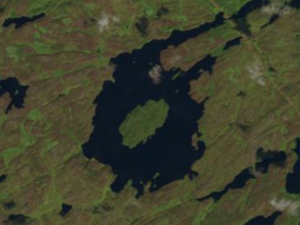Earth:Gow crater
 Gow Lake - Landsat OLI 37 | |
| Impact crater/structure | |
|---|---|
| Confidence | confirmed |
| Diameter | 5 kilometres (3 mi) |
| Age | < 250 million years old (Triassic) |
| Exposed | Yes |
| Drilled | No |
| Location | |
| Coordinates | [ ⚑ ] : 56°27′5″N 104°28′5″W / 56.45139°N 104.46806°W |
| Country | Canada |
| Lua error in Module:Location_map at line 522: Unable to find the specified location map definition: "Module:Location map/data/Saskatchewan" does not exist. | |
Gow is an impact crater in Saskatchewan, Canada.
It is 5 km (3 mi) in diameter and the age is estimated to be less than 250 million years (Triassic or later). The crater contains a classic crater lake with an island (Calder Island) formed by the central uplift.[1][2] It is the smallest known crater in Canada with an uplift structure.[3]
The crater is unique in that it is the only preserved example of a transitional impact structure on earth. This is characterized by a crater having relatively smooth walls and a floor partly or completely covered by debris slumped from the crater walls. The only other example existing is in Australia however is it extremely deteriorated. Due to this, the rock forming the crater bed is a unique form of breccia existing nowhere else on earth. This rock was formed when existing rock was liquified during the meteor impact. [4]
The larger Deep Bay crater, of Cretaceous age, is approximately 90 km east of Gow crater.
References
- ↑ "Gow". Earth Impact Database. Planetary and Space Science Centre University of New Brunswick Fredericton. http://www.passc.net/EarthImpactDatabase/New%20website_05-2018/Gow.html.
- ↑ Thomas, M.D.; Innes, M.J.S. (1977-03-03). "The Gow Lake impact structure, northern Saskatchewan". Canadian Journal of Earth Sciences (NRC Research Press) 14 (8): 1788–1795. doi:10.1139/e77-152. ISSN 1480-3313. Bibcode: 1977CaJES..14.1788T. http://www.nrcresearchpress.com/doi/pdf/10.1139/e77-152. Retrieved 2013-02-01.
- ↑ Pickersgill, A. E.; Lee, M. R.; Mark, D. F.; Osinski, G. R. (2015). "Shock Metamorphism in Impact Melt Rocks from the Gow Lake Impact Structure, Saskatchewan, Canada". Lunar and Planetary Science Conference (46th Lunar and Planetary Science Conference (2015)) (1832): 2181. Bibcode: 2015LPI....46.2181P. http://www.hou.usra.edu/meetings/lpsc2015/pdf/2181.pdf. Retrieved 2015-11-19.
- ↑ "Gow Lake crater in Saskatchewan a rarity on Earth". 2023-05-20. https://thestarphoenix.com/news/local-news/gow-lake-crater-in-saskatchewan-a-rarity-on-earth.
External links
 |



